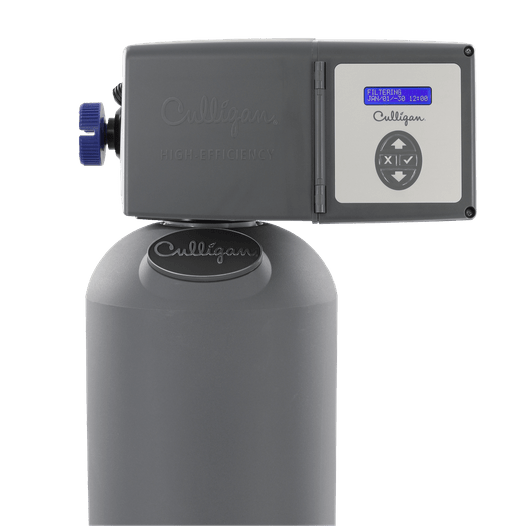Iron/Rusty Stains In Your Home
Iron is a nutrient that all bodies need to function. But it is also bad for your health if ingested in high doses.
The EPA considers iron a secondary contaminant, meaning it does not have a direct impact on your health as other dissolved solids such as lead. Because of this, your well water might have a higher amount of iron than the federal standards allow, however, it may not be enough to harm you. It can, however, wreak havoc on your home, causing costly damages and stains.

Four Types Of Iron
Red Iron
Ferric “insoluble” iron is visible to the naked eye and can cause a number of issues with your home, as well as in your food and drink. Red water iron can be removed by a water softener, but a more common treatment is an iron filter, which Culligan offers as a part of its whole home solutions. The state-of-the-art Iron-Cleer® water conditioning system solves iron and rust staining, leaving you with nothing but clean water in your sinks, fixtures, dishes and clothes.
Clear Iron
Ferrous “soluble” iron is an invisible dissolved solid that can appear after coming out of your faucet. This type of water is low on oxygen and typically comes from deeper wells and groundwater sources.
The most common way to treat clear iron is with a Culligan Water Softener, which can remove clear-water iron through ion exchange, particularly if your home’s water supply has a low pH. Other options, such as chlorination and manganese greensand filtration require maintenance and the proper amount of pressure.
Organic Iron
Generally, organic iron is pure iron combined with any dissolved organic matter in the water, such as tannins. A tannin is a biomolecule produced by vegetation that stains liquids, including tea and coffee. When tannins react with water containing iron, it creates a black residue. This usually occurs in shallow wells that are affected by groundwater.
Iron Bacteria
Iron bacteria are naturally occurring organisms in soils and groundwater that feed off iron, leaving waste deposits. They leave behind a dark sludge that sticks to pipes and fixtures, particularly in your water and toilet tanks and plumbing fixtures. The microorganisms also can lead to bad tasting and odorous water. You can physically remove the sludge from your toilet tank or use “shock” chlorination methods, but this is merely a temporary solution. The only way to reduce the amount of iron bacteria is to reduce the amount of iron itself.
How Can Iron Invade Your Well?
Via Seepage – Groundwater from rain or melted snow travels through the soil to become part of the water supply. If the soil has iron, it can dissolve with water and work its way into your well.
Via Corrosion – When iron is exposed to oxygen, it forms rust. Rust flakes can make their way into your water supply from corroded plumbing fixtures such as pipe and casings. This is the main cause of “colored water” you may see coming from your tap, toilet or shower head.
Harmful Effects Of Iron In Your Home
Laundry Stains – Yellow, red or brown stains can appear on your clothes if your laundry water contains a high amount of rust bacteria.
Ceramic/Porcelain – Iron can create stains in your sinks, toilets and tubs that are tedious and difficult to remove. Common home remedies include lemons/lemon juice, vinegar and baking soda, but these solutions are temporary and don’t take care of iron at the source.
Clogging – Iron can clog anything from wells and pumps to dishwashers, washing machines and other appliances and accessories. This requires expensive and time-consuming repairs or replacements.
Iron Water Treatment
While you can spot treat iron in your water chemically, the most common and effective way to address this problem is with a water softener or special filtration system.
Softeners and filters work by removing dissolved solids, like iron, calcium, and magnesium, that make water “hard.” This process varies between filters and softeners, but typically uses a resin bed that traps harder minerals and trades them out for another, softer substance — usually sodium. What’s left is cleaner, better-tasting water that works harder around your home.
Metallic Taste
If you’ve ever noticed a metallic taste in your water, it’s probably from an excess of iron. This offensive taste can ruin a good cup of coffee, tea and other home beverages produced from tap water. Food, particularly vegetables, can also absorb the taste of iron water, causing it to taste different.
Solutions
Suggested Products

Aquasential™ Smart High Efficiency Water Softener
- Smart brine tank auto-monitors salt levels
- Convenient auto-bypass valve
- Reliable non-corrosive valve
- Worry-free maintenance

Aquasential™ Smart High Efficiency Whole House Water Filters
Reduce sediments in your water and contaminants that cause your water to appear, taste, and smell unpleasant. Your system can also lessen the taste and odor of chlorine, and prevent pipe damage and staining from low pH water. Additional customizations include:
- Culligan® Filtr-Cleer® Water Filters – Reduces Sediment Problems
- Culligan® Cullar® Water Filters – Reduces Taste and Odor Problems
- Culligan® Cullneu Water Filters – Reduces Acid Problems

Facebook